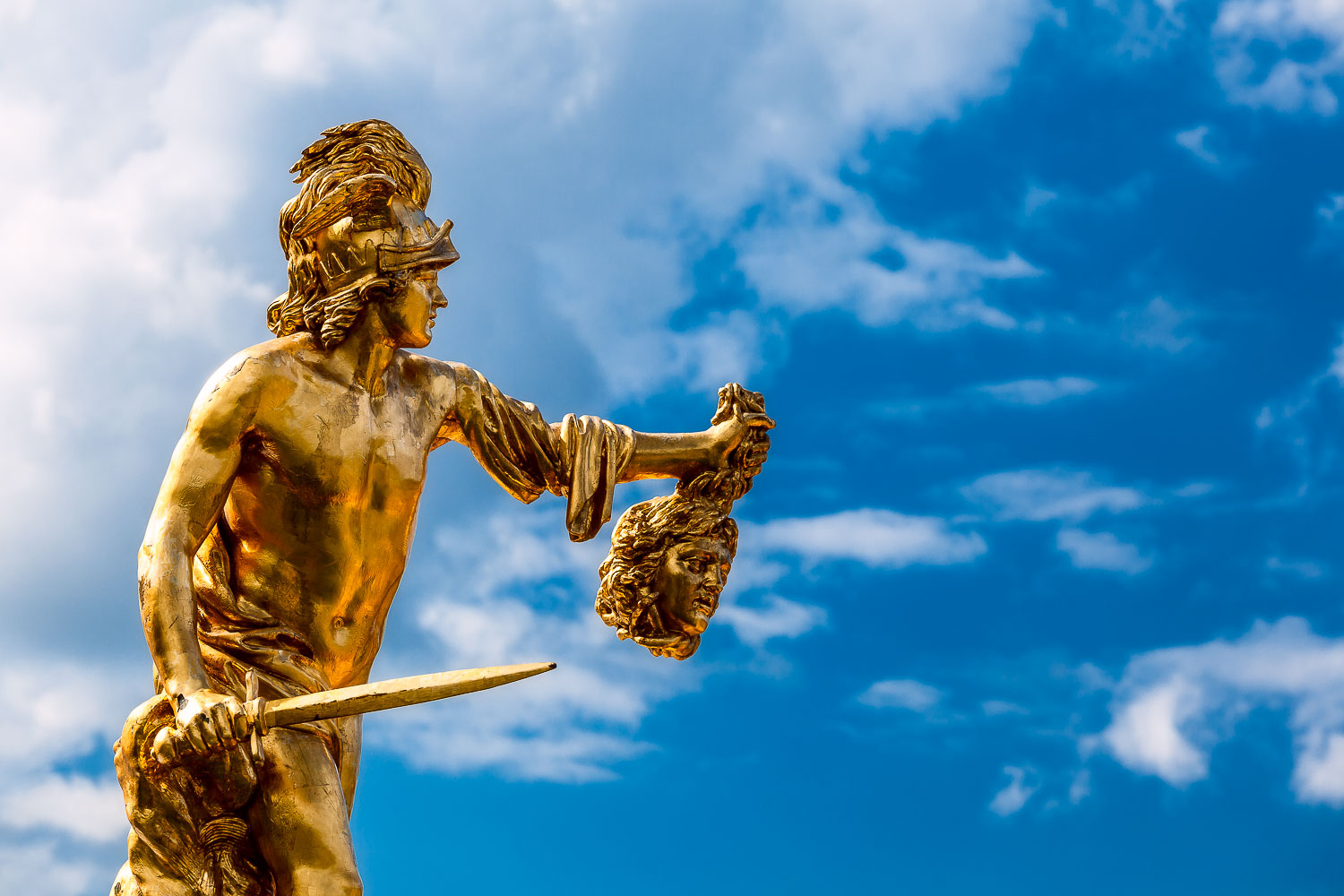How to Photograph Peterhof Palace, Russia
A black and white image showing a rear view of the Grand Cascade at Peterhof Palace near St. Petersburg, Russia.
Peterhof Palace is a short excursion from the city of St. Petersburg in Russia. It’s a fantastic location to visit and you’ll have great fun photographing the grandeur that is Peterhof.
Located in the municipal town of the same name, which was known as Petrodvorets from 1944 to 1997, Peterhof Palace was commissioned by Peter the Great and is sometimes referred to as the Venice Of The North.
I made the trip on a sunny summer’s afternoon and had a wonderful time wandering the grounds and photographing the fountains, statues and gardens for which Peterhof Palace is famous.
What Makes Your Photos Special
Wherever possible I think it’s worth exploring a more expansive approach to telling the story of your own visit.
As well as making the expected images of iconic sites it’s often a good idea to also photograph less well know elements at the same location.
After all, you want your images to reflect your own experience of the location in question. You’ll achieve this by exploring your own, authentic vision which you’ll discover by trusting your intuition and allowing creativity to flow.
About To Travel?
Make Photos That Explore Your Authentic Vision
Often the best way to explore your creativity is to take a more physical approach to your photography.
This might involve photographing from high or low vantage points or by moving around the subject in question to see how different directions of light affect the image.
Likewise, a more experimental approach to image processing on the desktop can allow you to separate your images from those made by a happy snapper.
Photography is such a fun, accessible and affordable way to explore your creativity.
Abstraction, which removes the subject from reality, can be achieved in a variety of ways, the easiest of which is by rendering the original color file into black and white. You can do this in camera or on the desktop with applications like Adobe Lightroom.
A young boy, surprised by water sprouting from the ground at Peterhof Palace near St. Petersburg, Russia.
How to Tell the Story of Your Visit to Peterhof St Petersburg
In a traditional photo essay the photo at the very top of this post might be considered to be a good opening or establishing image.
It presents a broad overview of the location and enough interesting elements, within a single picture, to entice the viewer to want to learn more.
Thus the need to produce a varied selection of images, as I’ve done with my own exploration of Peterhof Grand Palace.
However, to tell the story of the site more thoroughly it’s a good idea to continue to work the location. Here’s what else I photographed:
Individual statues, some as portraits
Statues in relationship to the water, sprouting up from below
A groundsman working hard to clean the fountain. While dressed appropriately he was, nonetheless, being absolutely pelted by the water falling down on him from above.
Exteriors of important buildings within the grounds of Peterhof
Portraits and candid images of fellow tourists
Statue on the edge of the fountain at Peterhof Palace near St. Petersburg, Russia
Photographing the Fountains at Peterhof Palace St Petersburg
The Grand Cascade at Peterhof Palace is probably the most famous water feature at Peterhof. The statues are all covered in gold leaf and look amazing in the bright sunlight.
I photographed the cascade from a number of different angles.
The photo at the top of this post places the cascade in relation to the grounds and a nearby pavilion. It shows a number of the elements (e.g., water, statues, building, lawns, trees) that describe the location without emphasizing one over the other.
Compare that to the close up view of one of the statues pictured with water showering down around it.
This variety of images provides the viewer with far more information than would be the case with, for instance, a series of similar photos of statues or fountains.
However, there is an argument for both approaches, depending on your motivation and the desired outcome.
Spectacular water fountains, beautifully framed by surrounding architecture, at Peterhof Palace near St. Petersburg, Russia.
Being Authentic While Satisfying The Needs Of Audience and Customers
Twenty something years ago I completed a Masters of Photography which consisted, largely, of photos made in temples across Asia.
While there were a few images that included people and architecture, most of the photos were portrait studies of buddha statues.
However, if I’d been commissioned to photograph one of these sites for a local tourist board or travel magazine I’d definitely be taking the photo essay approach I outlined previously.
Golden, onion shaped domains contrast with the cool aqua and green colors in the rest of the building at Peterhof Palace near St. Petersburg, Russia.
If ever you find yourself in St. Petersburg, Russia it’s well worth the effort to make an excursion out to Peterhof Palace by the shores of the Gulf of Finland.
It’s a wonderful place to explore, particularly on a lovely summer’s day.
You’d probably need a day to fully explore the grounds and numerous buildings on site. However, if photography is not the driving force determining your visit, half a day should suffice.
Just plan your trip carefully as traffic, there and back, can be heavy and you wouldn’t want the time spent in transit to reduce the time you have available to explore the many wonderful sites Peterhof Palace has to offer.
Your other option is to take the hydrofoil from the Hermitage Museum in St. Petersburg. It looks like a lot of fun and only takes around 30 minutes. Next time I think I’II try it.








Color is often the most important visual element in the scene you'll photograph. Here’s a simple truth that years of study and travel has taught me about color.